Knights of the Round Table
The Knights of the Round Table (Welsh: Marchogion y Ford Gron, Cornish: Marghekyon an Moos Krenn, Breton: Marc'hegien an Daol Grenn) are the knightly members of the legendary fellowship of King Arthur in the literary cycle of the Matter of Britain, appearing in literature since the mid 12th century. In this French-derived branch of Arthurian legend, the Knights are an order in the service of King Arthur, tasked with ensuring the peace of the kingdom and later leading the quest for the legendary Holy Grail. The Round Table, the place at which these characters of legend meet is a symbol of equality, and all members of the round table are thus, equal.
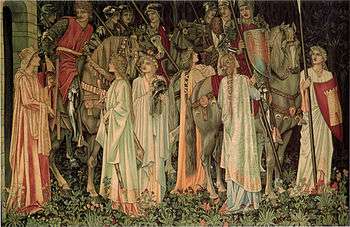
.png)
Different stories presented varying numbers of the knights, ranging from only a dozen to as many as one hundred or more. Bedivere, Gawain and Kay are the oldest characters associated with Arthur. Gawain was also one of those persistently most popular, alongside Lancelot, Percival and Tristan, each of them featured as protagonist or eponymous hero in multiple works of the chivalric romance genre. Other well-known members include Galahad, the most perfect knight in the later tradition wherein he replaced Percival as main achiever of the Grail, and the traitor Mordred. At the end of Arthurian prose cycles, including in the seminal Le Morte d'Arthur, the Round Table breaks down into warring factions following the revelation of Queen Guinevere's adultery with Lancelot.
In the same tradition, Queen Guinevere, earlier, has her own order of young warriors serving her personally, known as the Queen's Knights. Some romances also told of the Knights of the Old Table of Arthur's father and previous ruler, Uther Pendragon.
Number and partial list
Their number (including Arthur) and names vary greatly, depending on the text (the first written record of the Round Table and its knights is found in the Roman de Brut, written by the Norman poet Wace in 1155 but referring to the older tales of Brittany[1]). The figure may range from only a dozen through to 1,600, the latter as claimed by Layamon. Most commonly[2] there are between some 100 to 300 seats at the table, often times with one seat usually empty (300 was also chosen by Edward III of England when he decided to create his own Order of the Round Table at Windsor Castle in 1344[3]). In many versions, including the today best-known telling from Le Morte d'Arthur by Thomas Malory (following the Vulgate Lancelot), they have over one hundred members, as with 140 according to both Malory[4] (150 in Caxton's version) and Hartmann von Aue. Some sources state much smaller numbers, such as 13 in the Didot Perceval, 50 in the Prose Merlin (the expanded Vulgate Merlin has 250), and 60 in the count by Jean d'Outremeuse,[5][6] or higher, as with 366 in both Perlesvaus and the Chevaliers as deus espees.[7] The knights may include some the following:
| Knights of the Round Table | ||||
|---|---|---|---|---|
| Name | Other names | Introduction | Other medieval works | Notes |
| Accolon | Sir Accolon of Gaul | Post-Vulgate Cycle, c. 13th century | Le Morte d'Arthur | Lover of Morgan le Fay, accidentally killed in a joust with Arthur. |
| Aglovale | Agloval, Sir Aglovale de Galis | The Life of Sir Aglovale de Galis | King Pellinore's eldest son. | |
| Agravain | Agravaine | Lancelot-Grail, Le Morte d'Arthur | Second son of King Lot (of either Lothian or Orkney) and Arthur's sister Morgause. | |
| Arthur | Arthur Pendragon, Arturus, King Arthur | Y Gododdin, c. 7th century | Many | High King of the Britons, ruler of Logres and lord of Camelot. |
| Bagdemagus | Lancelot, the Knight of the Cart, 1170s | Meleagant's father and ruler of Gorre. | ||
| Bedivere | (Welsh: Bedwyr, French: Bédoier) Bedevere | Pa Gur yv y Porthaur, c. 10th century | Vita Cadoc, Culhwch and Olwen, Stanzas of the Graves, Welsh Triads, Historia Regum Britanniae, Le Morte d'Arthur, numerous others | Returns Excalibur to the Lady of the Lake; brother to Lucan. |
| Bors the Younger | Son of Bors the Elder, father of Elyan the White; Arthur's successor in some versions. | |||
| Brunor | Breunor le Noir, La Cote Male Taile ("The Badly-shaped Coat") | Knight who wears his murdered father's coat; brother of Dinadan and Daniel. | ||
| Cador | (Latin: Cadorius) | Historia Regum Britanniae, The Dream of Rhonabwy | Raised Guinevere as her ward, father to Constantine; described in some works as Arthur's cousin. | |
| Calogrenant | Colgrevance | Yvain, the Knight of the Lion, 1170s | Le Morte d'Arthur | Cousin to Sir Yvain. |
| Caradoc | (Latin: Caractacus) (Welsh: Caradog Freichfras, meaning Caradoc Strong Arm) (French: Carados Briefbras) | Perceval, the Story of the Grail, the Mabinogion | Rebelled against Arthur when he first became king, but later supported him. Sometimes two characters: Caradoc the Elder (a king) and Caradoc the Younger (a knight). | |
| Claudin | Lancelot-Grail, Le Morte d'Arthur | Virtuous son of the villain king Claudas. | ||
| Constantine III of Britain | Historia Regum Britanniae, c. 1136 | Le Morte d'Arthur | Arthur's cousin and successor to his throne; Cador's son. | |
| Dagonet | Arthur's court jester. | |||
| Daniel von Blumenthal | Daniel von Blumenthal, 1220 | Knight found in an early German offshoot of Arthurian legend. | ||
| Dinadan | Prose Tristan, 1230s | Le Morte d'Arthur | Son of Sir Brunor the Senior. | |
| Ector | Hector, Antor, Ectorius | Lancelot-Grail, early 13th century | Le Morte d'Arthur | Raises Arthur according to Merlin's command; father to Kay. |
| Elyan the White | (French: Helyan le Blanc) | Son of Bors | ||
| Erec | Unclear; first literary appearance as Erec in Erec and Enide, c. 1170 | See Geraint and Enid | Son of King Lac. | |
| Esclabor | Exiled Saracen king; father of Palamedes, Safir, and Segwarides. | |||
| Feirefiz | Wolfram von Eschenbach's Parzival, early 13th century | Half-brother to Percival; Arthur's nephew. | ||
| Gaheris | Le Morte d'Arthur | Son of King Lot and Morgause, brother to Gawain, Agravaine, and Gareth, and half-brother to Mordred. | ||
| Galahad | Lancelot-Grail, early 13th century | Post-Vulgate Cycle, Le Morte d'Arthur | Bastard son of Sir Lancelot and Elaine of Corbenic; the main achiever of the Holy Grail. | |
| Galehault | Galehalt, Galehaut | Lancelot-Grail, early 13th century | A half-giant foreign king, a former enemy of Arthur who becomes close to Lancelot. | |
| Galeschin | Galeshin | The Vulgate Cycle | Son of Elaine of Garlot and King Nentres; nephew of Arthur. | |
| Gareth | Beaumains | Le Morte d'Arthur, Idylls of the King | Also a son of King Lot and Morgause; in love with Lyonesse. | |
| Gawain | (Latin: Walwanus, Welsh: Gwalchmai, Irish: Balbhuaidh) | Culhwch and Olwen, c. 11th century | Conte du Graal, Lancelot-Grail cycle, Prose Tristan,Sir Gawain and the Green Knight, Le Morte d'Arthur and many short Middle English romances | Another son of King Lot and Morgause; father of Gingalain. |
| Geraint | Geraint and Enid | Enid's lover. | ||
| Gingalain | Guinglain, Gingalin, Gliglois, Wigalois, etc., also Le Bel Inconnu, or The Fair Unknown | Le Bel Inconnu | Gawain's son. | |
| Gornemant | Gurnemanz | Perceval, the Story of the Grail | Parzival | Mentor of Perceval. |
| Griflet | Girflet, Jaufre | Jaufré | A cousin to Lucan and Bedivere. | |
| Hector de Maris | Ector de Maris | Quest du Saint Graal (Vulgate Cycle) | Half-brother of Lancelot, son of King Ban; Bors and Lionel are his cousins. | |
| Hoel | (Welsh: Howel, Hywel) | The Dream of Rhonabwy, Geraint and Enid | Son of King Budic of Brittany; father to St. Tudwal. | |
| Kay | (Welsh: Cai, Latin: Caius) | Pa Gur yv y porthaur? 10th century | Many | Ector's son, foster brother to Arthur. |
| Lamorak | Prose Tristan, c. 1235 | Lancelot-Grail Cycle | Son of King Pellinore, brother to Tor, Aglovale, Percival, and Dindrane; lover of Morgause. | |
| Lancelot | Lancelot du Lac, Lancelot of the Lake, Launcelot | Erec and Enide, c. 1170 | Lancelot, the Knight of the Cart, Lancelot-Grail, many others | Son of King Ban from France, most famous for his affair with Queen Guinevere, father of Galahad; most prominent Knight of the Round Table in later romances. |
| Lanval | Landevale, Launfal, Lambewell | Marie de France's Lanval, late 12th century | Sir Landevale, Sir Launfal, Sir Lambewell | Enemy of Guinevere. |
| Leodegrance | Leondegrance | Guinevere's father, King of Cameliard. | ||
| Lionel | Lancelot-Grail, early 13th century | Son of King Bors of Gaunnes (or Gaul) and brother of Bors the Younger. | ||
| Lucan | Sir Lucan the Butler | Le Morte d'Arthur | Servant to King Arthur; Bedivere's brother, Griflet's cousin. | |
| Maleagant | Malagant, Meleagant, perhaps Melwas | Unclear, a similar character named "Melwas" appears in the 12th century Life of Gildas | Lancelot-Grail, Post-Vulgate Cycle, Le Morte d'Arthur | Abductor of Guinevere. |
| Mordred | Modred (Welsh: Medrawd, Latin: Medraut) | Annales Cambriae, c. 970 | Many | In the Round Table stories, Arthur's illegitimate son through Morgause. |
| Morholt | Marhalt, Morold, Marhaus | Tristan poems of Béroul and Thomas of Britain, 12th century | Tristan poems of Eilhart von Oberge, Gottfried von Strassburg, Prose Tristan, Post-Vulgate Cycle, Le Morte d'Arthur | Irish knight, rival of Tristan and uncle of Iseult. |
| Morien | Moriaen | Dutch romance Morien, 13th century | Half-Moorish son of Aglovale. | |
| Pelleas | Pellias | Post-Vulgate Cycle, 1230s | Le Morte d'Arthur | In love with Ettarre, later lover of Nimue. |
| Pellinore | Lancelot-Grail, Post-Vulgate Cycle | King of Listenoise and friend to Arthur. | ||
| Percival | (Welsh: Peredur) Perceval, Parzifal | As Percival, Erec and Enide, c. 1170 | Perceval, the Story of the Grail, Lancelot-Grail, many | Achiever of the Holy Grail; King Pellinore's son in some tales. |
| Safir | Thomas Malory's Le Morte d'Arthur, Prose Tristan | Son to King Esclabor; brother of Segwarides and Palamedes. | ||
| Sagramore | Sagramor | Lancelot-Grail, Post-Vulgate Cycle, Prose Tristan, Le Morte d'Arthur | Ubiquitous Knight of the Round Table; various stories and origins are given for him. | |
| Segwarides | Le Morte d'Arthur, Prose Tristan | Son of Esclabor; brother of Safir and Palamedes. | ||
| Tor | Le Morte d'Arthur | Son of King Ars, adopted by Pellinore. | ||
| Tristan | (Latin/Brythonic: Drustanus; Welsh: Drystan; Portuguese: Tristão; Spanish: Tristán) Tristran, Tristram, etc. | Beroul's Roman de Tristan | The two Folies Tristans, Marie de France's Chevrefeuil, Eilhart von Oberge, Gottfried von Strassburg, Prose Tristan, Post-Vulgate Cycle, Le Morte d'Arthur | King Mark's son or relative, Iseult's lover. |
| Urien | Uriens | Historical figure | Welsh Triads | King of Rheged (or Gorre), father of Yvain (Owain mab Urien) and husband of Morgan le Fay. |
| Yvain | (Welsh: Owain) Ywain, Ewain or Uwain | Based on the historical figure Owain mab Urien | Historia Brittonum, Yvain, the Knight of the Lion | King Urien's son. |
| Yvain the Bastard | Ywain the Adventurous, Uwain le Avoutres | Urien's illegitimate son. | ||
There have been furthermore many others, generally more or less obscure. For instance, Malory's own original[8] episode "Healing of Sir Urry" in the Winchester Manuscript of Le Morte d'Arthur additionally lists also the following:[9]
- King Anguish of Ireland
- Earl Aristance
- Sir Azreal
- Sir Arrok
- Sir Ascamore
- Sir Balan (brother of Sir Balin, whom he killed by accident in a duel in which both wore helmets and did not know who they were fighting)
- Sir Barrant le Apres (also known as the King with a Hundred Knights)
- Sir Bellenger le Beau
- Sir Belliance le Orgulous
- Sir Blamor de Ganis
- Sir Bleoberis de Ganis
- Sir Bohart le Cure Hardy (King Arthur's son)
- Sir Brandiles
- Sir Brian de Listinoise
- King Carados of Scotland
- Sir Cardok
- Duke Chalance of Clarence
- King Clariance of Northumberland
- Sir Clarus of Cleremont
- Sir Clegis
- Sir Clodrus
- Sir Colgrevance
- Sir Crosslem
- Sir Damas
- Sir Degrave sans Villainy (fought with the giant of the Black Lowe)
- Sir Degrevant
- Sir Dinas le Seneschal de Cornwall
- Sir Dinas
- Sir Dodinas le Savage
- Sir Dornar
- Sir Drian
- Sir Edward of Orkney
- Sir Epinogris (son of King Clariance of Northumberland)
- Sir Fergus
- Sir Florence (son of Gawain by Sir Brandiles's sister)
- Sir Gahalantine
- Sir Galihodin
- Sir Galleron of Galway
- Sir Gauter
- Sir Gillimer
- Sir Grummor Grummorson
- Sir Gumret le Petit
- Sir Harry le Fils Lake
- Sir Hebes (not Hebes le Renowne)
- Sir Hebes le Renowne
- Sir Hectimere
- Sir Helian le Blanc
- Sir Herminde
- Sir Hervis de la Forest Savage
- Sir Ironside (Knight of the Red Launds)
- Sir Kay l'Estrange (not Kay, Arthur's seneschal)
- Earl Lambaile
- Sir Lambegus
- Sir Lamiel
- Sir Lavain
- Sir Lovell (son of Gawain by Sir Brandiles's sister)
- Sir Mador de la Porte
- Sir Marrok (whose wife turned him into a werewolf)
- Sir Melias de l'Isle
- Sir Melion of the Mountain
- Sir Meliot de Logris
- Sir Menaduke
- Sir Morganor
- King Nentres of Garlot
- Sir Neroveus
- Sir Ozanna le Cœur Hardi
- Sir Perimones (brother to Persant and Pertolepe; called the Red Knight)
- Sir Persant
- Sir Pertolepe
- Sir Petipace of Winchelsea
- Sir Plaine de Fors
- Sir Plenorius
- Sir Priamus
- Sir Reynold
- Sir Sadok
- Sir Selises of the Dolorous Tower
- Sir Sentrail
- Sir Severause le Breuse (known for rejecting battles with men in favour of giants, dragons, and wild beasts)
- Sir Suppinabiles
- Earl Ulbawes
- Sir Urry
- Sir Villiars the Valiant
Conversely, the Winchester Round Table features only Sirs Alynore (Alymere), Bedwere (Bedivere), Blubtlrys (Bleoberis), Bors De Ganys (Bors de Ganis), Brumear (Brunor le Noir), Dagonet, Degore, Ectorde Marys (Ector de Maris), Galahallt (Galahault or Galahad), Garethe (Gareth), Gauen (Gawain), Kay, Lamorak, Launcelot Deulake (Lancelot du Lac), Lacotemale Tayle (La Cote Male Taile), Lucane (Lucan), Lybyus Dysconyus (Le Bel Desconneu), Lyonell (Lionel), Mordrede (Mordred), Plomyde (Palomedes), Pelleus (Pelleas), Percyvale (Percival), Safer (Safir), and Trystram Delyens (Tristram de Lyones) for the total of merely 24 (not counting Arthur).[10]
Selected members
Accolon
Aglovale

Aglovale de Galis or Agloval de Galles (also Aglaval, Agglovale, Aglovan, Aglovaus, etc.) is the eldest legitimate son of King Pellinore. Like his brothers Tor, Lamorak, Dornar and Percival, he is a Knight of the Round Table. In chivalric romances, Aglovale never cuts as impressive a figure as his brothers Lamorak and Percival, but his valor is unquestioned.
According to the Post Vulgate Cycle and Thomas Malory's Le Morte d'Arthur, it is he who first brings Percival to Camelot to be knighted. In the Vulgate Cycle, Aglovale dies accidentally at Gawain's hand during the Quest for the Holy Grail. However, in Malory he and his brother Tor are among the knights charged with defending the execution of Guinevere and are both killed when Lancelot and his men rescue the queen.
Aglovale appears prominently in the Dutch romance Morien. In a situation similar to Gahmuret's begetting of Feirefiz in Wolfram von Eschenbach's Parzival, Aglovale visits Moorish lands where he meets a beautiful black Christian princess and conceives a child with her. He returns to his own lands, and thirteen years later, his son Morien comes to find him. After a number of adventures, father and son are reunited and both return to Morien's country to take back their rightful lands.
In modern works, Aglovale is the eponymous protagonist of Clemence Housman's 1905 novel The Life of Sir Aglovale de Galis. T. H. White's book The Once and Future King gives a particularly endearing portrait of the knight.
Agravain
Arthur
Bagdemagus
Bedivere
Bors
Brunor
Cador
Calogrenant
Calogrenant, sometimes known in English as Colgrevance and in German (Diu Crône) as Kalogrenant (there are also many other variants, including Calogrenan[s/z], Calogrevant, Calogrinant, Colgrevaunce, Galogrinans, Kalebrant, Kalocreant, Qualogrenans), is a cousin to Yvain, and his courtesy and eloquence were known throughout the kingdom. Calogrenant first appears in Chrétien de Troyes' Yvain, the Knight of the Lion, telling a story to a group of knights and Queen Guinevere about an adventure he had in the forest of Brocéliande, where had heard of a magic spring in those woods which could create a huge storm whenever someone poured its water into a nearby basin. Calogrenant reached the spring and summoned the storm, after which a knight named Esclados attacked him for causing such havoc, and soundly defeated Calogrenant, but did not kill him. Calogrenant's cousin Yvain is upset that Calogrenant never told him of this defeat, and sets out to avenge him, embarking on the adventure that sets up the remainder of events in the romance.
His character has been derived from the Welsh mythological hero Cynon ap Clydno, usually the lover of Owain's sister Morvydd, although in Owain, or the Lady of the Fountain Cynon is stated to be the son of Clydno, possibly connected to Clyddno Eiddin.[11] Roger Sherman Loomis and other scholars speculated that Calogrenant was used specifically as a foil for Kay in some lost early version of the Yvain story. In Chrétien's romance he is presented as everything Kay is not: polite, respectful, and well-mannered. By this theory, his name can be deconstructed to "Cai lo grenant", or "Cai the grumbler", which would represent another opposite characteristic of Kay, who was famous for his acid tongue.[11]
Calogrenant appears later in the Lancelot-Grail cycle as an excellent knight, though his kinship to Yvain is not as clear as in Chrétien. He dies during the Grail Quest while trying to keep Lionel from killing his own brother, Bors. Bors had faced a dilemma over whom to rescue between Lionel, who was getting beaten with thorns by two rogue knights, and a maiden who had just been abducted, and chose the maiden over his brother. Lionel was not pleased by this, and attacked Bors the next time he saw him. A religious hermit tried to intervene, but was killed accidentally in the process, and Calogrenant stepped in. Bors would not fight his brother, and Lionel slays Calogrenant and goes after Bors until God steps in and renders him immobile.
Thomas Malory recounts Calogrenant's death scene in his Le Morte d'Arthur, but also includes another one later in the narrative. Despite dying on the Grail quest, he turns up as one of the twelve knights who help Agravaine and Mordred trap Lancelot and Guinevere together. Lancelot has no armour or weapons, but manages to pull Calogrenant into the room and kills him, then uses his sword to defeat the rest of Mordred's companions.
Caradoc
Claudin
Prince Claudin (Claudine, Claudyne, Claudino), is the son of the Frankish King Claudas of the Wasteland (de la Deserte). He appears in the Lancelot-Grail and in Le Morte d'Arthur. His father is a villain during King Arthur's early reign, an enemy to Arthur's allies Ban and Bors, but Claudin is a virtuous young man and wants no part of his father's schemes. Claudas eventually succumbs to Arthur and company, losing his kingdom, and Claudin seeks adventure elsewhere. In Vulgate Cycle version of the Grail Quest, he is a companion of Bors the Younger, Galahad and Perceval.
Dagonet
Dinadan
Elyan
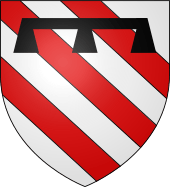
Elyan the White or Helyan le Blanc (also Helin le Blank; Elain, Helain, Hellaine) is son of Bors the Younger. His mother is King Brandegoris' daughter Claire, who tricked Bors into sleeping with her using a magic ring; this is sometimes said to be the only time Bors broke his vow of chastity. Elyan is later accepted as a member to the Round Table, where he becomes known as an excellent knight. Like his father and the rest of his family, Elyan helps his cousin Lancelot rescue Guinevere after their affair is exposed and then joins him in exile.
Elyan's mother Claire is the half-sister of Sagramore; their mother is the daughter of the Eastern Roman Emperor. According to the Lancelot-Grail Cycle, Elyan eventually became Emperor of Constantinople himself.
In modern works, Elyan the White was portrayed as Guinevere's brother in the 2008 TV series Merlin. Appearing as just Elyan, he was played there by black actor Adetomiwa Edun.
Erec

Erec, the son of King Lac features in numerous Arthurian tales (notably the Post-Vulgate Cycle), but he is most famous as the protagonist in Chrétien de Troyes' first romance, Erec and Enide. Because of Erec and Enide‘s relationship to the Welsh Geraint and Enid, Erec and Geraint are often conflated or confused.
In Chrétien's story, Erec meets his future wife Enide while on a quest to defeat a knight who had mistreated one of Guinevere's servants. The two fall in love and marry, but rumours spread that Erec no longer cares for knighthood or anything else besides his domestic life. Enide cries about these rumours, causing Erec to prove his abilities, both to himself and to his wife, through a test of Enide's love for him. He has her go on a long, tortuous trip with him where she is forbidden to speak to him. She breaks his conditions several times to warn him of danger, and after a number of adventures that prove both his love and his abilities, husband and wife are reconciled. When Erec's father Lac dies, Erec inherits his kingdom.
In the Post-Vulgate Cycle and the Guiron le Courteous version of Palamedes, King Lac is himself a Knight of the Round Table. The Post-Vulgate Quest of the Holy Grail tells of Lac's murder by the sons of his brother, King Dirac. Erec is then slain by Gawain before he can attempt to regain his father's kingdom from their rule.
Esclabor
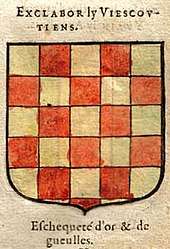
Esclabor (Esclabort, Astlabor, Scalabrone) is a pagan lord of Babylon or Galilee in Arthurian legend. He is the father of Palamedes, Safir, and Segwarides, among others. While visiting Rome, he saves the life of the Roman Emperor, and then goes to Arthur's Logres, where he rescues King Pellinore. Esclabor eventually retires to Camelot, later adventuring with Palamedes and Galahad during the Grail Quest. Shortly after converting to Christianity, an act necessary for the full admission into the brotherhood of Round Table,[12] Esclabor commits suicide from grief upon learning of Palamedes' death by Gawain.
Feirefiz
Gaheris
Galahad
Galehaut
Galeschin
Galeschin (Galeshin, Galescin, Galessin, Galachin, Galathin, Galescalain, Galeschalains, Galaas, etc.) is a nephew of King Arthur, son of the king's half-sister Elaine and King Nentres of Garlot. He appears in the story of the Dolorous Tower in the Vulgate Cycle, as he and his cousin Yvain attempt to rescue Gawain from the wicked Carados but are taken captive as well; the trio are eventually rescued by Lancelot. Galeschin is referred to as the Duke of Clarence,[13] an anachronism as the duchy of Clarence was not created until 1362. Though mentioned in a few other Arthurian stories, Galeschin's role is ultimately minor. He is further rescued by Lancelot in other occasions, including from the Vale of No Return.
Roger Sherman Loomis derives the name Galeschin from the name Galvariun, found on the Modena Archivolt. He theorises that the name was altered to make it sound more like Galesche, the Old French word for Gaul, and derives the name Galvariun from the epithet Gwallt Euryn, found in Culhwch and Olwen, which he translates as "golden hair".
Gareth
Gawain
Geraint
Gingalain
Gornemant
Gornemant of Gohort, also known as Gornemant de Goort (or Gurnemans of Gorhaut, among other variants such as Gornemans or Gormans), was Percival's mentor. He is mentioned in a few early romances, but achieves prominence in Perceval, the Story of the Grail, where he instructs the young hero in the ways of knighthood. Gornemant's niece is Blanchefleur, whom Percival later marries after successfully defending her city against attackers. Wolfram von Eschenbach also gives him three sons (Gurzgi, Lascoyt, Schentefleurs), as well as a daughter named Liaze, who falls in love with Percival but he declines to marry her.
In modern works, his character became famous as Gurnemanz in Richard Wagner's opera Parsifal, in which he is one of the main Grail Knights.
Griflet

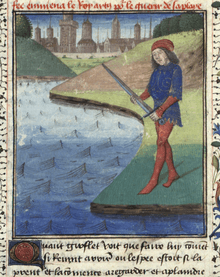
Griflet /ˈɡrɪflɪt/, also called Gi(r)flet or Jaufré, is a knight in Arthurian legend. He is the hero of his own, early romance: Jaufre, the only surviving Arthurian romance written in Provençal.[14]
In French prose chivalric romance cycles, Griflet first appears as a squire and one of King Arthur's earliest allies. He is called the son of Do or Don, and is a cousin to Lucan and Bedivere.[15][14] When he is knighted, he becomes one of the first Knights of the Round Table.[16] Griflet is one of Arthur's chief advisors throughout his career. According to the Lancelot-Grail Cycle, he was one of the few survivors of Arthur's final battle and was asked by the dying king to return his sword Excalibur to the Lady of the Lake. In Le Morte d'Arthur, however, Sir Griflet is one of the knights killed by Lancelot's rescue party at the execution of Guinevere, making Griflet's cousin Bedivere the knight who casts away Excalibur.
Like many another character in Arthurian Romance, his origins lie in Welsh mythology. In this instance, it is the minor deity Gilfaethwy fab Dôn, who features in Math fab Mathonwy, fourth of the Four Branches of the Mabinogi.[17]
Hector de Maris

Hector de Maris (Ector de Maris, Hestor des Mares) is the younger half-brother of Lancelot and the natural son of King Ban of Benwick and the Lady de Maris; Bors and Lionel are his cousins. He should not be mistaken with Ector, the father of Kay and foster father of Arthur.
Hector's adventures in the name of King Arthur were many and wide-ranging. With Morganore, it was Hector de Maris who welcomed Tristan to Camelot when he was shipwrecked nearby. The two jousted in a friendly competition, but Hector was ashamed to have been beaten by a knight of Cornwall. Other times he was more successful at tournaments, getting the better of both Palomides and Percivale. He, however, failed to defeat Turquine and became one of the knights he imprisoned before being rescued by his brother, Lancelot. He returned the favour by rediscovering the lost Knight of the Lake after his period of insanity and returning him to the court. He is known to have had a long relationship with Lady Perse of the Narrow Borderland, whose fiancé he murdered in order to be with her. Hector later had an affair with the cousin of the Lady of Roestoc, before being reunited with Perse. Hector also participates in the Grail Quest, but he is one of the many knights who prove unworthy of achieving the object. In the Quest du Saint Graal of the Vulgate Cycle, Hector and Gawain are travelling together when they experience a vision of what Jessie Weston called an "unintelligent" variation on the theme of the perilous Black Hand in other romances in the Grail Cycle.[18]
When Lancelot is caught in his affair with Guinevere, however, Hector stands by his half-brother and leaves court with him. He becomes one of the top leaders of Lancelot's faction, participating in the battle to rescue the queen at her execution, and the defence of Lancelot's castle Joyous Guard. Like all his family, he joins Lancelot in France when they are expelled from Arthur's kingdom, and he helps defeat the army led by Mordred's sons after the Battle of Camlann (Salisbury). He then joins his brother at the Archbishop of Canterbury's hermitage, and later dies on a crusade in the Holy Land.
Hoel
Kay
Lamorak
Lancelot
Lionel
Lucan
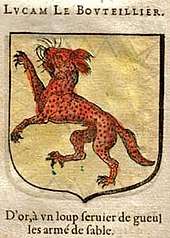
Lucan the Butler (also Lucanere de Buttelere, Lucans li Bouteillier, Lucas the Botiller, Lucant, Lucanus, etc.) is a servant of King Arthur and the son of Duke Corneus, brother to Bedivere and cousin to Griflet. He and his relatives are among Arthur's earliest allies in the fight against the rebel kings such as Lot, Urien and Caradoc, and remained one of Arthur's loyal companions throughout his life.
Lucan was a solid and reliable Knight of the Round Table and one of King Arthur's earliest companions. He took on the post of royal butler – an important position in charge of the royal household rather than a serving man. The duties of a "butler" have changed over time; Lucan was supposed to have been in charge of the royal court, along with Bedivere the Marshal and Kay the Seneschal. He valiantly defended Arthur's right to the throne at the Battle of Bedegraine and against subsequent rebellions. Though he sought adventure, he never came to the fore in Arthurian tales with renowned exploits of his own. He always attended the royal tournaments and was once hurt so badly by Tristram that Yvain had to escort him to Gannes Abbey for medical assistance.
In most accounts of Arthur's death, from the Lancelot-Grail cycle to Le Morte d'Arthur, Lucan is one of the last knights at the king's side at the Battle of Camlann and is usually the last of them to die. Lucan remained loyal to King Arthur throughout the schism with Lancelot and on occasion acted as their go-between. Similarly, he stayed by the monarch's side during Mordred's rebellion and tried to dissuade Arthur from his final attack on his son/nephew, but was unsuccessful and the King received his mortal wound. Gravely wounded himself, Lucan was one of the few knights left at the field of Camlann, along his brother, Bedivere. Worried about looters on the battlefield, Lucan and Bedivere attempt to move the dying Arthur into a nearby chapel for safety, but the strain is too much for Lucan as a severe wound bursts open, spilling out his bowels; he dies from his own wounds just before the king returns Excalibur to the Lady of the Lake and sails off for Avalon. Though the knight Arthur asks to cast the sword into the lake is usually Griflet (Lancelot-Grail) or Bedivere (Le Morte d'Arthur, the Alliterative Morte Arthure, the Stanzaic Morte Arthur), the 16th-century English ballad King Arthur's Death ascribes this duty to Lucan.[19]
In modern treatments, a character named Lucan appears in the 2004 film King Arthur. Played by Johnny Brennan, he is a young boy found and cared for by Arthur's warrior Dagonet.
Meliant
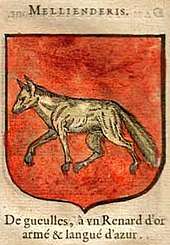
Meliant (variants of the name include Melians and Melyans) is featured in several Arthurian romances.
In the writings by Chrétien de Troyes and Wolfram von Eschenbach, Meliant de Lis is the King of Lis and one of the Round Table. Along with Bagdemagus and Meleagant, Maliant declares war on his foster-father named Tiebaut or Lyppaut after being rejected by the latter's daughter Obie. Gawain, fighting for Obie's sister Obilot, captures Meliant, who then reconciles with Obie in her captivity. A different version of this story, as told by Heinrich von dem Türlin, names him Fiers von Arramis, whom Gawain also forces to surrender to a young lady who is a sister of his beloved (Flursenesephin). In the Livre de Artus, Meliant de Lis marries Gawain's own lover Floree.
In the Vulgate Cycle's Queste Melians de Danemarche (Denmark, "Dianarca") joins Galahad (who had knighted him earlier), Bors and Percival at Castle Corbenic at the end of the Grail Quest.[20] King Arthur appoints him to the Round Table, but Meliant later sides with Lancelot in the civil war. In reward for his support, including a role in the rescue of Guinevere, Lancelot makes him one of his earls in his domains on the continent.
There are also other Arthurian characters by this name. For instance, one Meliant (named Brano in the Italian La Tavola Ritonda) is a relative of King Faramon's daughter Belide when she falsely accuses Tristan of rape in the Prose Tristan. In the Vulgate Lancelot, Carados of the Dolorous Tower takes Melyans le Gai's wife as his mistress.[21] Another Meliant from the cycle is an ancestor of Gawain (himself is descended from Peter, an early Christian follower of Joseph of Arimathea) in the Vulgate Estoire del Saint Graal. In Perlesvaus, Meliant is an enemy lord of Arthur, allied with the traitorous Kay; he is killed by Lancelot who had previously also slain his evil father.
Mordred
Morholt
Morholt (also called Marhalt, Marhault, Morold, Marhaus and other variations) is an Irish warrior who demands tribute from King Mark of Cornwall until he is slain by Tristan, Mark's nephew and defender. In many versions of the legend, Morholt's name is prefaced with a definite article (i.e. The Morholt) as if it were a rank or a title, but scholars have found no reason for this.[22]
He appears in almost all versions of the legend of Tristan and Iseult, beginning with the verse works of Thomas of Britain and Béroul. In the early material, Morholt is the brother of the Queen of Ireland and the uncle of Tristan's future love (both mother and daughter are named Iseult). He comes to Cornwall to collect tribute owed to his country, but Tristan agrees to battle the champion on the remote Saint Samson's Isle in order to release his people from the debt. Tristan mortally wounds Morholt, leaving a piece of his sword in the Irishman's skull, but Morholt stabs him with a poisoned spear and escapes to Ireland to die. The injured Tristan eventually travels to Ireland incognito to receive healing from the Iseult the Younger, but is found out when the queen discovers the piece of metal found in her brother's head fits perfectly into a chink in Tristan's blade.
The authors of later romances expanded Morholt's role; in works like the Prose Tristan, the Post-Vulgate Cycle, and Thomas Malory's Le Morte d'Arthur, he is a Knight of the Round Table before his fateful encounter with Tristan. The prose romances add many more details to Morholt's career; the Post-Vulgate and Malory record his adventures with the young Gawain and Yvain early in King Arthur's reign. In the later versions, Tristan takes Morholt's place at the Round Table when he joins the company himself.
Palamedes
Pelleas
Pellinore
Percival
Priamus
Priamus is a Roman ally of Emperor Lucius in Le Morte d'Arthur. He claims to be descended from Alexander of Africa and Judas Maccabeus. Upon meeting Gawain in The Tale of King Arthur and Emperor Lucius, he betrays Lucius to join forces with King Arthur.[23]
Safir
Safir or Safere (Safire, Saphar) is the youngest son of the Saracen king Esclabor in the Arthurian legend. A courageous and loyal knight, he was a popular romance character, showing up in the Prose Tristan and Le Morte d'Arthur, and having his name included on the Winchester Round Table. Two of his brothers, Segwarides and Palamedes, also belong to the Round Table.
Safir appears in many works of Arthurian literature, usually alongside his brother Palamedes. Though he is a younger brother, Safir converted to Christianity some time before Palamedes. In one story, Safir is disguised as Ector de Maris and fights with Helior le Preuse, defeats him, and wins Espinogres' lady. Vowing to defend the lady's honour, Palamedes arrives on the scene, and locks sword with Safir, not realising it is his brother. After fighting for an hour, both are impressed with each other's prowess and skill, and decide to ask the other's identity. Safir is devastated to find that he was fighting with his own brother and asks Palamedes for forgiveness; together, they return the lady to Espinogres. When the affair between Lancelot and Guinevere is exposed, Safir and Palamedes join Lancelot's side in the ensuing civil war between Lancelot and King Arthur. When they are banished to Lancelot's homeland in Gaul, Safir is made Duke of Landok while Palamedes becomes Duke of Provence.
Sagramore
Segwarides
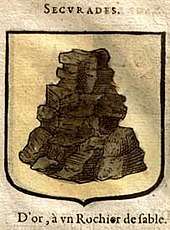
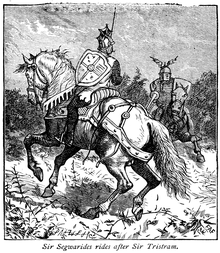
Segwarides (Securades, Segurades, Seguradez) is a liegeman of King Mark who is cuckolded by Tristan in the Prose Tristan and Thomas Malory's Le Morte d'Arthur. Malory also lists a knight of this name as a son of the Saracen king Esclabor, his brothers being Palamedes and Safir; it seems there were originally two characters of this name, but the stories in which they appear fail to differentiate between them.
In Malory, Tristan has a brief affair with Segwarides' wife, and wounds the knight after being found out. Tristan encounters Segwarides later on the Isle of Servage. Segwardies forgives the more famous knight saying he "will never hate a noble knight for a light lady" and the two team up to avoid the dangers of the isle. Soon afterwards, Tristan makes Segwarides the Lord of Servage. Segwarides is eventually killed trying to repel Lancelot's rescue of Guinevere from the stake.
Tor

Tor appears frequently in Arthurian literature. In earlier mentions Tor's father is King Ars or Aries,[24] but the Post-Vulgate Cycle and Thomas Malory's Le Morte d'Arthur say this man is his adoptive father while his natural father is King Pellinore.[25][26]
In the Post-Vulgate and Malory, Tor is brother to Aglovale, Lamorak, Dornar, Percival, and Dindrane. He is born when Pellinore sleeps with his mother "half by force", and she marries Aries shortly afterward; here Aries is not a king, but a shepherd. Tor and his twelve half-brothers are raised as shepherds, but Tor dreams of being a knight. Finally his parents take him to King Arthur's court, and Arthur makes the boy one of his first knights. Later Merlin reveals Tor's true parentage, and Pellinore embraces his son; neither Aries nor his wife seem offended. Tor distinguishes himself at the wedding feast of Arthur and Guinevere when he takes up a quest to retrieve a mysterious white brachet hound that had come into the court. According to Malory, Tor and his brother Aglovale are among the knights charged with defending the execution of Guinevere and they both die when Lancelot and his followers rescue the queen.[27]
Tristan
Urien
Yvain
Yvain the Bastard
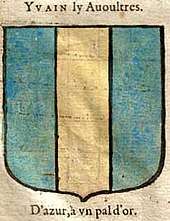
Yvain the Bastard (Yvain[s] li/le[s] Avou[l]tres, -l'Avoltre, -li Batarz) is a son of King Urien of Gore. He is often confused with his half-brother Yvain, after whom he was named; while the older Yvain is Urien's legitimate child from his wife Morgan le Fay, Yvain the Bastard was sired by Urien on the wife of his seneschal.
He is encountered frequently in Arthurian romance as a hearty and sensible warrior. His death comes at the hands of his cousin Gawain during the Quest for the Holy Grail. The two, disguised by their armour, meet and decide to joust, during which Yvain is mortally wounded; it is not until Gawain takes him to a hermitage for his last rites that he realises he has fought, and killed, his own cousin.
The Queen's Knights and the Old Table

The Queen's Knights (Chevaliers de la Roine) are the knights who serve King Arthur's wife Queen Guinevere in the Old French prose cycles. They are also known in French texts like the "Knights of Queen Guinevere" (Chevaliers de la Roine Guenievre, the form used in the Livre d'Artus[28]) and the more elaborate "Valiant Knights of Queen Guinevere" (Chevalier vaillant de la Roine Gueneure[29]). In the Middle English compilation Le Morte d'Arthur, the simple "Queen's Knights" form is used by the author Thomas Malory who also describes them as "a grete felyshyp of men of arms".[30] Members of this group carry only plain white shields, often accompanying the queen and engaging in rivalry against the more experienced Knights of the Round Table.[31][32] Heroes Gawain and Lancelot are among those who first serve as the Queen's Knights in their youth after being knighted by Arthur, before winning enough honour to be promoted to fill the Round Table when a vacancy occurs. In Malory's version, Lancelot later rescues a new generation of them when they are captured together with Guinevere by the villain Maleagant.
Some French and Italian prose romances and poetry feature the original fifty knights of the Round Table from the times of Uther Pendragon, the late father of King Arthur, known in Italian retellings of the Prose Tristan as the Old Table (Tavola Vecchio).[33] Their stories include that of Branor the Dragon Knight, "the flower of the Old Table",[34] unsurpassed in his skills even at the age of over 100.
References
- Kibler, William W. (1991). "Round Table." In Lacy, Norris J. (Ed.), The New Arthurian Encyclopaedia, p. 391. New York: Garland. ISBN 0-8240-4377-4.
- Daniel Mersey, Myths & Legends: The Knights of the Round Table, page 4.
- Jennifer Westwood, Albion: A Guide to Legendary Britain, page 314.
- Withrington, John (1993). ""HE TELLETH THE NUMBER OF THE STARS; HE CALLETH THEM ALL BY THEIR NAMES": THE LESSER KNIGHTS OF SIR THOMAS MALORY'S "MORTE DARTHUR"". Quondam et Futurus. 3 (4): 17–27 – via JSTOR.
- Theresa Bane, Encyclopedia of Mythological Objects, page 132.
- Christopher W. Bruce, The Arthurian Name Dictionary, page 140.
- https://books.google.com/books?id=TjsWBQAAQBAJ&pg=PA97
- "A New Companion to Malory". 2019. doi:10.2307/j.ctv136bvg0 – via JSTOR. Cite journal requires
|journal=(help) - Thomas Malory's Le Morte D'Arthur, the Winchester Manuscript. Edited and abridged by Helen Cooper, this book was published by Oxford University Press in 1998.
- Martin Biddle, Sally Badham, A.C. Barefoot, Round Table: An Archaeological Investigation, pages 255-260.
- Loomis, Roger (1949). Arthurian Tradition and Chretien De Troyes. Columbia University Press.
- Armstrong, Dorsey (2006). "The (Non-) Christian Knight in Malory: A Contradiction in Terms?". Arthuriana. 16 (2): 30–34 – via JSTOR.
- Loomis (1997), p. 63
- Bruce, Christopher W. (2013). The Arthurian Name Dictionary. Routledge. pp. 220–221. ISBN 9781136755385. Retrieved 2 November 2017.
- Monaghan, Patricia (2014). The Encyclopedia of Celtic Mythology and Folklore. Infobase Publishing. p. 230. ISBN 9781438110370. Retrieved 2 November 2017.
- The Story of King Arthur and His Knights. C. Scribner's Sons. 1909. pp. 45–48. Retrieved 2 November 2017.
- Gantz, Jeffrey; trans. (1976) The Mabinogion. London and New York: Penguin Books. ISBN 0-14-044322-3.
- Weston, Jessie L. From Ritual to Romance 1920 Chapter XIII The Perilous Chapel.
- "King Arthur's Death" is a continuation of the ballad "The Legend of King Arthur". See Noble, James (1991). "King Arthur's Death". In Lacy, Norris J. (Ed.), The New Arthurian Encyclopedia, pp. 262–263. New York: Garland. ISBN 0-8240-4377-4.
- Loomis (1997). p. 157.
- Loomis (1997). p. 11.
- Curtis, Renée L. (translator) (1994). The Romance of Tristan, Oxford. ISBN 0-19-282792-8.
- "Le Morte Arthur", Le Morte d'Arthur, De Gruyter, ISBN 978-3-11-139216-5, retrieved 26 March 2020
- For example, Chrétien de Troyes' list of knights in Erec and Enide. From Owen, Arthurian Romances.
- Lacy, Lancelot-Grail, volume 4.
- Malory, Le Morte d'Arthur, Book III, ch. IV, p. 83.
- Malory, Le Morte d'Arthur, Book XX, ch. VII, p. 880.
- Heinrich Oskar Sommer, The Structure of Le Livre d'Artus, and Its Function in the Evolution of the Arthurian Prose-Romances, page 22.
- Ulrike Bethlehem, Guinevere, a Medieval Puzzle: Images of Arthur's Queen in the Medieval Literature of England and France, page 392.
- Arthurian Interpretations, Volume 3, page 87.
- Phyllis Ann Karr, The Arthurian Companion, page 539.
- Beverly Kennedy, Knighthood in the Morte d'Arthur, page 119.
- Proceedings of the British Academy, Volume 15, page 206.
- The Arthur of the Italians: The Arthurian Legend in Medieval Italian Literature and Culture, page 78.
Sources
- Chrétien de Troyes; Owen, D. D. R. (translator) (1988). Arthurian Romances. New York: Everyman's Library. ISBN 0-460-87389-X.
- Lacy, Norris J. (Ed.) (1 April 1995). Lancelot-Grail: The Old French Arthurian Vulgate and Post-Vulgate in Translation, Volume 4 of 5. New York: Garland. ISBN 0-8153-0748-9.
- Malory, Thomas; Bryan, Elizabeth J. (introduction) (1994). Le Morte d'Arthur. New York: Modern Library. ISBN 0-679-60099-X. (Pollard text.)
- Loomis, Roger Sherman (1997). Celtic Myth and Arthurian Romance. Academy Chicago Publishers. ISBN 0-89733-436-1.
- Wilson, Robert H. The "Fair Unknown" in Malory. Publications of the Modern-Language Association of America (1943).
External links
| Wikimedia Commons has media related to Knights of the Round Table. |